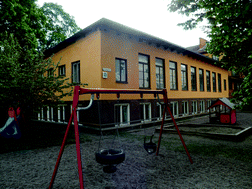Fungal DNA and pet allergen levels in Swedish day care centers and associations with building characteristics
Abstract
Pet allergens and mold growth related to damp are common phenomena in day care centers in Sweden but exposure measurements of these factors are lacking. The aim of this study was to investigate the relationship between building construction and indoor environment quality in Swedish day care centers and the potential for exposure to fungi (analyzed by quantitative PCR) and animal allergens (analyzed by ELISA). Measurements were performed in 21 day care centers (103 rooms) from one municipality in Sweden, which were identified as constructions at risk of dampness (85% of the buildings) and with visible damage and mold growth (54% of the buildings). Dust samples were collected using cotton swab and Petri dishes. Total fungal DNA was detected in 99% and 100%, Aspergillus/Penicillium DNA in 54% and 68%, and Stachybotrys chartarumDNA in 4% and 9% of the investigated rooms in cotton swab and Petri dish samples, respectively. The total fungal DNA levels (Geometric Mean, GM) were 4.2 × 106cell equivalents per m2 and 2.9 × 105cell equivalents per m2 per day in the swab and Petri dish samples, respectively. The concentrations (GM) of cat (Fel d1), dog (Can f1), and horse (Equ cx) allergens were 9.4, 7.2 ng m−2 day−1, and 5.0 unit per m2 per day, respectively. Total fungal DNA levels were higher in risk construction buildings (p = 0.01), in rooms with linoleum flooring material (p = 0.003), and in buildings with rotating heat exchangers (p = 0.02). There were associations between total fungal DNA levels and cat (p = 0.02), dog (p < 0.001), and horse (p = 0.001) allergens. In conclusion, risk constructions, damp constructions, mould growth, fungal DNA, and animal allergens were common exposure factors in Swedish day care centers. Building constructions that represent a high risk for internal dampness should be avoided in the future, and measures to reduce allergen levels should be considered to protect pet-allergic children from asthmatic problems.


 Please wait while we load your content...
Please wait while we load your content...